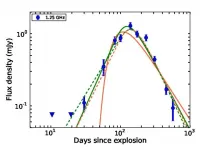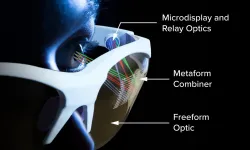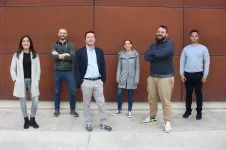uGMRT reveals for the first time the patchy environment of a rare cosmic explosion
2021-05-03
(Press-News.org) Scientists from the National Centre for radio Astrophysics of the Tata Institute of Fundamental Research (NCRA-TIFR) Pune used the upgraded Giant Metrewave Radio Telescope (uGMRT) to determine that AT 2018 cow, the first of a newly discovered class of cosmic explosions, has an extremely patchy environment. Sources like AT 2018cow release an enormous amount of energy, nonetheless fade extremely rapidly. This along with their extremely blue color has led to them being called FBOTs for Fast Blue Optical Transient. This is the first observational evidence of inhomogeneous emission from an FBOT. The origins of FBOTs are still under debate, but proposed models include explosion of a massive star, collision of an accreting neutron star and a star, merger of two white dwarfs, etc.
The FBOTs are difficult to find since they appear and vanish in the sky very quickly. However, several of them have been discovered in the past few years via the recent advent of surveys that scan the sky almost on daily basis. FBOTs that also emit in the radio are doubly rare, but are particularly interesting because radio observations help one to determine the properties of the environments of these explosions and their progenitors.
The FBOT AT2018cow was discovered on 16 June 2018. At a distance of about 215 million light-years, the "cow" showed luminosities much greater than that of normal supernovae. Prof. Poonam Chandra (NCRA-TIFR) and Dr. A. J. Nayana (a former Ph.D. student of Prof. Poonam Chandra) carried out radio observations of AT 2018cow with the uGMRT to determine the properties of its extended environment and emission region. "Our study has tremendously benefited by the unique low-frequency capabilities of the uGMRT. The uGMRT observations of the "cow" played an unique role in finding the non-uniform density around this explosion", says Nayana. She added, "Our work provides the first observational evidence of inhomogeneous emission from an FBOT. The density of the material around this explosion falls drastically around 0.1 light-year from the transient. This indicates that the progenitor star of AT2018cow was shedding mass much faster towards its end of life."
AT 2018cow is also unusual in that it has been observable in the radio for a very long time. The longer one can observe the post explosion emission, the more distance the material that was ejected during the explosion has traveled. This allows one to study the large scale environment of the source. Dr. A. J. Nayana and Prof. Poonam Chandra have been observing the "cow" for ~ 2 years with the uGMRT to understand its properties. "This is the first FBOT seen for this long at low radio frequencies and the uGMRT data gave crucial information about the environment of this transient.", Nayana said. Poonam Chandra explains, "This is the beauty of low-frequency radio observations. One gets to trace the footprints of the progenitor system much before it exploded. It is interesting that the material from the explosion is moving with speed greater than 20% speed of light even after ~257 days post-explosion, without any deceleration".
While the origin of FBOTs is still under debate, detailed radio observations can give hints about various physical parameters of these events like the speed of the material that came out of this explosion, the magnetic field strength, the rate by which the progenitor system sheds its mass before the explosion, etc. The uGMRT observations of the "cow" suggest that the progenitor erupted its material ~100 times faster during the years close to its end-of-life compared to ~23 years before the explosion. Also, AT2018cow showed inhomogeneities in the radio-emitting region whereas the other two radio bright FBOTs did not show these properties, making the "cow" unique in the group. "Observations of more FBOTs with the uGMRT will give information about their environments and progenitors to develop a comprehensive picture of the properties of these intriguing transients.", says Nayana.
The GMRT is an array of thirty 45-m antennas spread over 25 sq-km area in Khodad village, Narayangaon, India, built and operated by NCRA-TIFR, Pune. Currently it is one of the most sensitive low frequency radio telescope in the world.
The paper was published in the April 30, 2021 issue of The Astrophysical Journal Letters.
INFORMATION:
[Attachments] See images for this press release:

ELSE PRESS RELEASES FROM THIS DATE:
2021-05-03
"Image" is everything in the $20 billion market for AR/VR glasses. Consumers are looking for glasses that are compact and easy to wear, delivering high-quality imagery with socially acceptable optics that don't look like "bug eyes."
University of Rochester researchers at the Institute of Optics have come up with a novel technology to deliver those attributes with maximum effect. In a paper in Science Advances, they describe imprinting freeform optics with a nanophotonic optical element called "a metasurface."
The metasurface is a veritable forest of tiny, silver, nanoscale structures on a thin metallic film that conforms, in this advance, to the freeform shape of ...
2021-05-03
According to Michael Twidale, professor in the School of Information Sciences at the University of Illinois Urbana-Champaign, bad usability can be an irritation for everyone but "especially awful" for the underprivileged. In "Everyone Everywhere: A Distributed and Embedded Paradigm for Usability," which was recently published in the Journal of the Association for Information Science and Technology (JASIST), Twidale and coauthors David M. Nichols (University of Waikato, New Zealand) and Christopher P. Lueg (Bern University of Applied Sciences, Switzerland) present a new paradigm to address the persistence of difficulties that people have ...
2021-05-03
(New York, NY) - May 3, 2021 - In advance of a wildfire season projected to be among the worst, the American Thoracic Society has released a report that calls for a unified federal response to wildfires that includes investment in research on smoke exposure and forecasting, health impacts of smoke, evaluation of interventions, and a clear and coordinated communication strategy to protect public health.
The report, Respiratory Impacts of Wildland Fire Smoke: Future Challenges and Policy Opportunities, was published online ahead of print in the Annals of the American Thoracic Society on May 3, 2021.
The report comes at a time when the U.S. is experiencing an increasing frequency of very large destructive wildfires, due to years ...
2021-05-03
Over 400 common disinfectants currently in use could be made safer for people and the environment and could better fight the COVID-19 virus with the simple application of UVC light, a new study from the University of Waterloo shows.
Benzalkonium chloride (BAK) is the most common active ingredient in many disinfectants regularly used in hospitals, households, and food processing plants to protect against a wide range of viruses and bacteria - including all strains of SARS-CoV-2, the coronavirus that causes COVID-19 - but its toxicity means that it can't be used in high concentrations. It also means that products containing BAK are harmful to humans ...
2021-05-03
LUGANO, Switzerland, 3 May 2021 - As breast cancer becomes a largely curable disease, with more than 70% of women surviving at least 10 years after diagnosis across most of Europe thanks to early detection and treatment, (1) the quality of life after cancer has become an important aspect of the patient journey - one that may be inadequately addressed with current standards of follow-up. A study presented at the ESMO Breast Cancer 2021 Virtual Congress (2) has shown that breast cancer survivors differ widely in the burden of symptoms they experience after the end of treatment and thereby revealed an unmet need for tailored approaches to follow-up care. (3)
Lead author Kelly de Ligt ...
2021-05-03
TORONTO - Scientists at the Krembil Brain Institute, part of University Health Network (UHN), in collaboration with colleagues at the Centre for Addiction and Mental Health (CAMH), have used precious and rare access to live human cortical tissue to identify functionally important features that make human neurons unique.
This experimental work is among the first of its kind on live human neurons and one of the largest studies of the diversity of human cortical pyramidal cells to date.
"The goal of this study was to understand what makes human brain cells 'human,' and how human neuron circuitry functions as it does," says Dr. Taufik Valiante, neurosurgeon, scientist at the Krembil Brain Institute at UHN and co-senior author on the paper.
"In our study, we wanted ...
2021-05-03
Customised medicines could one day be manufactured to patients' individual needs, with University of East Anglia (UEA) researchers investigating technology to 3D 'print' pills.
The team, including Dr Andy Gleadall and Prof Richard Bibb at Loughborough University, identified a new additive manufacturing method to allow the 3D printing of medicine in highly porous structures, which can be used to regulate the rate of drug release from the medicine to the body when taken orally.
Dr Sheng Qi, a Reader in Pharmaceutics at UEA's School of Pharmacy, led the research. The project findings, 'Effects of porosity on drug release kinetics of swellable and erodible porous pharmaceutical solid dosage forms ...
2021-05-03
A research team from the Institut de Neurociències at the Universitat Autònoma de Barcelona (INc-UAB) has showed that inhibition through a drug of the Tac2 neuronal circuit, involved in the formation of the memory of fear, has opposite effects on the ability to remember aversive events in mice according to sex: it is reduced in male mice and increased in female mice.
Is the first time that a drug has been shown to produce this opposite effect on the memory of male and female mice. The study also evidences that opposing molecular mechanisms and behaviours can occur ...
2021-05-03
Diatoms are tiny unicellular plants -- no bigger than half a millimeter -- which inhabit the surface water of the world's oceans where sunlight penetration is plenty. Despite their modest size, they are one of the world's most powerful resources for removing carbon dioxide (CO2) from the atmosphere. They currently remove, or "fix," 10-20 billion metric tons of CO2 every year by the process of photosynthesis. But not much is known about which biological mechanisms diatoms use, and whether these processes might become less effective with rising ocean acidity, temperatures, and, in particular, CO2 concentrations. A new study in Frontiers in Plant Science shows that diatoms predominantly ...
2021-05-03
New research shows that planned cesarean deliveries on maternal request are safe for low-risk pregnancies and may be associated with a lower risk of adverse delivery outcomes than planned vaginal deliveries. The study is published in CMAJ (Canadian Medical Association Journal).
The study used province-wide data from the Better Outcomes Registry & Network (BORN), Ontario's provincial birth registry. The authors analyzed data on 422,210 low-risk pregnancies over 6 years (2012 to 2018). There were 46,533 cesarean deliveries, of which 1827 (3.9%) were planned at the request of the mother; this proportion was unchanged during the years of study. Mothers who requested cesarean delivery ...
LAST 30 PRESS RELEASES:
[Press-News.org] uGMRT reveals for the first time the patchy environment of a rare cosmic explosion




